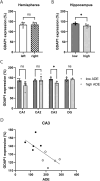Expression of GDAP1 Gene Correlates With Alcohol Deprivation Effect
- PMID: 40251787
- PMCID: PMC12008164
- DOI: 10.1111/gbb.70022
Expression of GDAP1 Gene Correlates With Alcohol Deprivation Effect
Abstract
Alcohol addiction is a widespread disease, and the exact causes and consequences are still not fully determined. Neurotransmitters and neuronal circuits are not only the target structure of alcohol and responsible for its direct effects but also play a central role in the development of addiction. A gene that has been linked to alcohol use disorder in recent studies is the ganglioside-induced differentiation-associated protein 1 (GDAP1) gene. The present study focuses on the hippocampus, a brain region particularly vulnerable to alcohol and rich in Gdap1 gene expression. Using an established drinking model, alcohol drinking behavior was induced in adult male Long Evans rats. After 6 weeks of voluntary alcohol intake, followed by 2 weeks of deprivation, the animals were divided into two groups based on the alcohol deprivation effect (ADE). Gdap1 gene expression was measured with real-time PCR in the hippocampus. Results reveal significantly decreased mRNA expression in the high ADE group compared to the low ADE group. This decrease was specifically detected within the cornu ammonis 3 (CA3) region. Gdap1 expression in this region also negatively correlated with ADE in all animals. Taken together, results indicate that Gdap1 might not only be associated with alcohol consumption but might even play a role in alcohol dependence.
Keywords: addiction; hippocampus; real‐time PCR; rodent models; voluntary drinking.
© 2025 The Author(s). Genes, Brain and Behavior published by International Behavioural and Neural Genetics Society and John Wiley & Sons Ltd.
Conflict of interest statement
The authors declare no conflicts of interest.
Figures


Similar articles
-
Alcohol deprivation effect is prolonged in the alcohol preferring (P) rat after repeated deprivations.Alcohol Clin Exp Res. 2000 Jan;24(1):8-16. Alcohol Clin Exp Res. 2000. PMID: 10656186
-
The expression of an alcohol deprivation effect in the high-alcohol-drinking replicate rat lines is dependent on repeated deprivations.Alcohol Clin Exp Res. 2000 Jun;24(6):747-53. Alcohol Clin Exp Res. 2000. PMID: 10888060
-
Different brain oxidative and neuroinflammation status in rats during prolonged abstinence depending on their ethanol relapse-like drinking behavior: Effects of ethanol reintroduction.Drug Alcohol Depend. 2022 Mar 1;232:109284. doi: 10.1016/j.drugalcdep.2022.109284. Epub 2022 Jan 11. Drug Alcohol Depend. 2022. PMID: 35033958
-
The alcohol deprivation effect model for studying relapse behavior: a comparison between rats and mice.Alcohol. 2014 May;48(3):313-20. doi: 10.1016/j.alcohol.2014.03.002. Epub 2014 Apr 1. Alcohol. 2014. PMID: 24811155 Review.
-
Animal models of alcoholism: neurobiology of high alcohol-drinking behavior in rodents.Crit Rev Neurobiol. 1998;12(4):339-69. doi: 10.1615/critrevneurobiol.v12.i4.40. Crit Rev Neurobiol. 1998. PMID: 10348615 Review.
References
-
- WHO , “Global Status Report on Alcohol and Health 2018.” (2018).
-
- Beresford T. P., Arciniegas D. B., Alfers J., et al., “Hippocampus Volume Loss due to Chronic Heavy Drinking,” Alcoholism: Clinical and Experimental Research 30 (2006): 1866–1870. - PubMed
MeSH terms
Substances
Grants and funding
LinkOut - more resources
Full Text Sources
Medical
Research Materials
Miscellaneous

